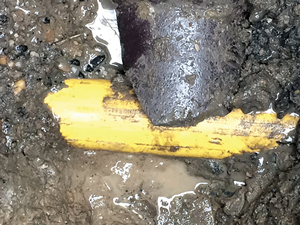
Be alert for cross bores
Welcome to National Grid’s Tips of the Trade. National Grid is committed to your safety and these tips are intended to help you work safely near our facilities. Please review these tips with your coworkers at your tailgate or toolbox meetings before work begins.
Call before you clear a sewer clog or blockage
Some sewer laterals may have natural gas pipelines intersecting them. So before clearing any clogged sewer or drain lines, it’s critical that you contact National Grid to ensure you can proceed without the risk of puncturing a natural gas line. Please call our dedicated 24-hour emergency/dispatch number at National Grid. How natural gas lines intersect sewer linesNational Grid uses horizontal directional boring to install natural gas lines underground beneath streets, driveways and mature trees. This approach is common in the utility industry because it causes less environmental disruption than open digging. National Grid currently uses techniques to detect sewer lines during directional digging. However, because many older sewer lines are not easily identifiable, in the past we may have unintentionally bored our gas lines directly through sewer lines in what are known as “cross bores.” Know the dangersA cross bore in a sewer lateral will impede flow and lead to eventual blockage. A worker who attempts to remove the blockage can accidentally cut the gas line and cause a dangerous release of natural gas. The resulting loss of service may not be immediately apparent. Gas can migrate undetected through the lateral and concentrate in sewer lines and nearby structures, causing a potential hazard. Take these steps to work safely:
Would you like to know more?Additional overhead and digging guidelines, case studies, instructional videos and training tools can all be found, at no charge to you, on National Grid’s e-SMARTworkers website. Do you like this email series? Do you find the information helpful? We’d like to know. Please reply to this email and tell us what you think, or let us know what topics you’d like to see in future emails. For more contractor safety information, visit ngridsafety.com.
|
|||||||||
 |
Smell Gas. Act Fast. |
||||||||
Call 811 or enter an online request at least 72 hours before digging in Massachusetts and Rhode Island, and at least 48 hours in New York, excluding weekends and legal holidays:
| |||||||||
|
|||||||||
| #10765 |
